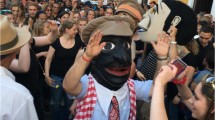
Overview
- Provides a unique exploration of the effect of US cultural hegemony on Cuban and Haitian culture
- Elaborates on the role of two often marginalized nations in the formation of American racial identities
- Takes an interdisciplinary approach to analysis, citing examples from a range of primary sources
Part of the book series: Palgrave Studies in Theatre and Performance History (PSTPH)
Access this book
Tax calculation will be finalised at checkout
Other ways to access
About this book
Similar content being viewed by others
Keywords
Table of contents (8 chapters)
-
Front Matter
-
Back Matter
Reviews
“Riley’s sophisticated study expands and challenges our knowledge of race, empire, and nation. She shows that the U.S. did not just export racial ideas and practices to the Caribbean islands it occupied and attempted to control. Race at home was also remade in ruling, fearing, and imagining Cuba and Haiti. Seeing music and performance more generally as sites of empire’s memory and forgetting Performing Race and Erasure brilliantly shows that a hardening sense that race could be reduced to black and white took shape outside the U.S. as well as inside.” (David Roediger, Foundation Distinguished Professor of International & Interdisciplinary Studies, University of Kansas, USA)
Authors and Affiliations
About the author
Bibliographic Information
Book Title: Performing Race and Erasure
Book Subtitle: Cuba, Haiti, and US Culture, 1898–1940
Authors: Shannon Rose Riley
Series Title: Palgrave Studies in Theatre and Performance History
DOI: https://doi.org/10.1057/978-1-137-59211-8
Publisher: Palgrave Macmillan London
eBook Packages: Literature, Cultural and Media Studies, Literature, Cultural and Media Studies (R0)
Copyright Information: The Editor(s) (if applicable) and The Author(s) 2016
Hardcover ISBN: 978-1-137-59210-1Published: 17 June 2016
Softcover ISBN: 978-1-349-95506-0Published: 07 June 2018
eBook ISBN: 978-1-137-59211-8Published: 22 June 2016
Series ISSN: 2947-5767
Series E-ISSN: 2947-5775
Edition Number: 1
Number of Pages: XIII, 273
Number of Illustrations: 6 b/w illustrations
Topics: Theatre History


